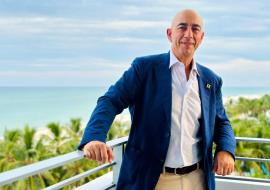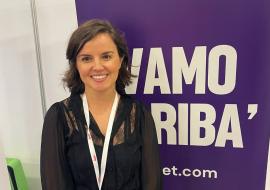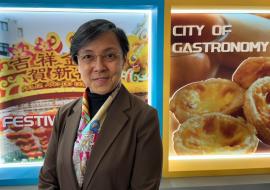The Sector’s Strategy Zeroes in on Sustainability

Within the framework of 2015 International Tourism Fair (FITUR), CND talked to Petra Cruz, Europe director of the Dominican Republic’s Tourism Ministry, about the results and performance of the travel industry in her country in 2014.
What do you think about having a Gastronomic Academy in your country?
The creation of the Gastronomic Academy in the Dominican Republic, inaugurated by President Danilo Medina in August 2014, gives a significant boost to the positioning of our country at the highest level of that activity.
Having an Academy is very important because of the possibilities it provides in terms of the regulation and classification of gastronomic establishment on the Island, which can have a positive impact on tourist outbound levels from Europe.
We’re very happy about, since the gastronomic experience is one of the key elements when it comes to choosing a destination to be visited, especially in the case of European travelers as they demand high standards. Those standards can be met with the certification of restaurants, thus satisfying the sophisticate European markets.
How many European tourists visited the Dominican Republic in 2014?
The Dominican tourism sector had an extraordinary year, as we received 5 million visitors from around the world.
One out of five tourists comes from Europe and, by the end of 2014, 1.1 million European vacationers had traveled to our country. The list was headed by the German market, with 230,000 travelers and an 8 percent growth (all in all, the European tourism went 5.3 percent up).
What’s the significance of the beginning of Iberia’s operations in the Dominican nation in terms of reeling in more European tourists, specifically from Spain?
With the agreement signed by the Dominican Republic’s Tourism Minister, Mr. Francisco Javier Garcia, Iberia has committed to increase the frequency from 5 to 7 weekly flights, which entails a daily flight, and the airlift growth to the country will directly raise the number of tourists visiting us, not only from Spain, but the whole Europe.
Iberia is one of the continent’s main airlines and establishes airlift from several European cities, and Santo Domingo can be reached via Madrid.
What’s the interest of European tourists that have never before traveled to this Caribbean island and what do you have to offer?
The European tourists are exactly asking for what we have defined in our marketing strategies, since these studies precisely aim at getting ahead of consumers’ desires, demands and needs.
This guideline has helped us divide the destination into segments that, beyond offering sun and beach as the utmost attractions, also foster nature tourism, eco-tourism, adventure tourism and golf.
As for golf tourism, we’re already leaders in the Caribbean and Latin America, with world-class golf courses and the entire infrastructure required by that activity, keeping in mind that those who practice this sport demand high quality levels and the average expense is higher than usual.
According to recent studies, nearly 70,000 tourists travel to the Caribbean island with the direct aim of playing golf, and we’re looking forward to receiving 100,000 golf-interested visitors in a three-year term.
What are the main outbound markets in terms of the golf segment?
The United States and Europe.
As for the new roads in your country, do you have the number of tourists that choose a rent- and-drive plan?
I don’t have the exact figures, but I can tell that we have a growing number of vacationers renting cars and driving throughout the island with their own plans, since we have remarkably improved the road public infrastructure.
With the opening of the highway that links Puntacana and Santo Domingo, a two-hour drive, and the one from Puntacana to Miches, which was inaugurated in December by Dominican President, Danilo Medina, we have created a road circuit that shortens distances among those cities.
We’re working to open new roads and highways to improve the access to such tourism circuits as Navarrete and Puerto Plata, in an effort to give tourists the opportunity to visit the most attractive places in different regions.
Does that plan include the creation of new roads and that kind of infrastructure to Santiago de los Caballeros and the south of the Island?
The Puerto Plata-Navarrete highway is presently being constructed and it shall be inaugurated this year; while the southwest region is included in another stage of the strategic plan.
The Russian market has grown over the past three years and the German one currently ranks first. What do you make of the tourism possibilities in that East European nation in the light of the crisis it’s facing?
Regrettably, we’re not exempt from taking the impact of the crisis that is affecting the Russian market, since the devaluation of ruble means less buying power and everything is now more expensive over there. Some statistics are already reflecting that reality, showing the decrease in 2014. But we hope that the situation is going to be better, the Russian market, economic-political stability will be normalized, and the figures will go up again.
What are the leading tour operators in the German market?
The German market is controlled by its three main tour operators: TUI, Thomas Cook and Dertouristik.
Is there anything else you’d like to add?
Just remember that the Dominican Republic is going to host 2015 Bienvenido, the megafam trip organized by T.O. Meier's Weltreisen with its 100 finest travel agencies, among other events and meetings of great importance for both national and regional tourism, thus fostering our destination in outbound markets.














